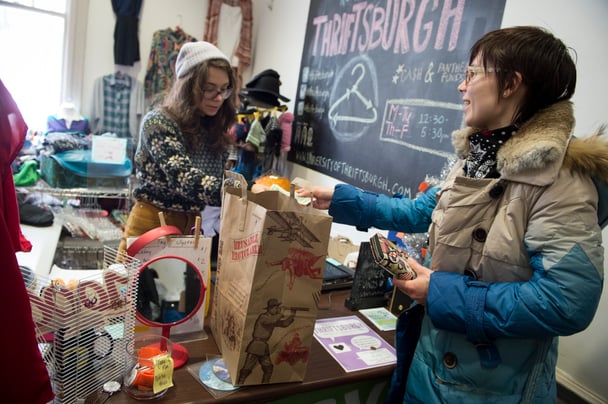
Since the pandemic began, online shopping has been all the craze. Whether it be for clothing or other goods, we have become dependent on online shopping. While these online stores are convenient, they come at a cost - they’re rather unsustainable in a multitude of ways: economically, environmentally, and socially. In terms of fair trade, environmental costs, shipping pollution, and retail prices, plenty of companies have failed to align with many consumers’ moral compasses.
Thankfully, some online stores are very cognizant of their environmental impact. Some stores, many being online thrift stores, have succeeded by using “zero” or low waste packaging, offsetting carbon emissions, operating locally, and continuing to spread awareness about textile sustainability. Companies such as Goodfair, Etsy, Depop, Poshmark, and Swap, are on their way to become the new “shopping mall”. Over time, many thoughtful consumers have become more ethically conscious of the waste and troubles that fast fashion has produced.
One particular issue with the sustainability of these online stores is that of packaging and shipping. Packaging can use recycled materials, but more often than not, it is composed chiefly of plastics, styrofoams, and single-use cardboard. Not to mention, the carbon footprint of actually transporting the packages (sometimes across the country, or even across the ocean) adds to the problem even more. Although a secondhand garment is certainly a more sustainable fashion option, the logistics of transporting that article of clothing to the consumer is anything but sustainable.

Luckily for students (and the general public) around the University of Pittsburgh campus, our little thrift store - the University of Thriftsburgh - has great picks, low prices, and is plenty sustainable. Being local is a big advantage, because not only is the walk to O’Hara Street to pick up clothing better for the environment, it also ensures that that cute jacket you want to buy doesn’t take three weeks (or more) to ship. Thriftsburgh is run by myself (Kira Klein) and my coworkers Hannah Lempert and Hannah Chen, and our director Erika Ninos. As the store is a member of the Student Office of Sustainability, or the Pitt “SOOS,” we intentionally think about the footprint of every action we make. Our clothes are locally donated and locally sold. If garments are unable to be sold (sometimes they’re a bit too tattered), we send them to textile recycling facilities, and thus divert them from landfills. We’re also socially conscious of clothing accessibility. Our clothes have low prices, with a maximum of $10 for coats and jackets. Our store has also donated several boxes of clothing to other student groups this past semester, some of which went to help the homeless population of Pittsburgh.
However, like many businesses, Thriftsburgh had to adapt to the conditions of the pandemic, and we joined the online selling bandwagon. Technically, none of us were really trained for this -- we had been hired to run an in-person retail store, not an online shop -- but thankfully, we’re adaptable and creative college students who are well versed in social media.

First, we had to figure out how to sell to people when they couldn’t really come into our store… at least not like they had before. We didn’t know how long this whole “remote thing” would last (unfortunately it’s proving to be quite a while), so having an online platform was certainly something to consider. Should we spend tons of time, energy, and money to craft an online store, and stock it with everything we had? Should we open a store on a pre-existing online thrifting service, like Depop or Poshmark? Eventually, we settled on a platform that we know and love, is easy to use, and that we already have a significant following on: Instagram. Honestly, it wasn’t the most conventional shop, but the ease of use and visibility meant that we could simply make Instagram posts with the clothes that we wanted to sell, have people message us to claim them, and then they could pick up and pay in store when we were open.
Well, the process wasn’t entirely “simple”. Plenty of questions came up in the process that we hadn’t expected to deal with. For example, how safe was handling cash in a pandemic? The University didn’t allow us to take credit cards before, but could we ask to use them now, if they were safer and easier? Can we still apply store credit? How do we process donations safely? How do we social distance in our store if it’s one room and several people are already working in it? Thankfully, our team could ask different groups within the University for help with answering these questions, and we figured many things out ourselves, as well. Over time, we began to have pretty smooth sailing in our new business model.

We decided that our traditional method of transaction when someone came to pick up would work just fine -- we accept cash, Panther Funds, and store credit. Donations were set aside in the store to quarantine for several days before we went through and processed them. To ensure social distancing, we put a table in front of our entrance and used it as a selling counter of sorts, while employees could work inside the store.
As for the actual promotion and selling, we came up with a whole process that became quite successful on Instagram. We decided that for each post, we would have around ten items for sale, with basic information on their pictures like a description, size, brand, and price. So, Hannah Lempert and I went to work on deciding what each post should be. As a fun marketing tool, and a helpful organization tool, we often “themed” our posts. For example, we had some based on different styles, such as “Alternative” and “Dark Academia.” We grouped these clothes together in the store. We took photos of the clothing sets, uploaded them, and used the free app Canva to design our posts. With this platform, we could apply text, formatting, colors, and designs, to make the posts more fun and visually appealing. Then, we set up a schedule and posted several times a week, whether it be a new round of sweaters or outdoors wear. One of us would be in charge of managing the direct messages, or “DMs,” of the Thriftsburgh Instagram (@thriftsburgh) each week. We kept track of the clothing for sale, such as what had already been sold, on a shared spreadsheet.
This process took some refining, and certainly had a lot of steps, but we did have a lot of fun coming up with these Instagram posts, styling clothes, taking pictures, and designing the images. However, you might notice that it is a bit of a convoluted process. So, what does the future of Thriftsburgh hold? Well, a little birdie told me we’re working on an online store with more items, a smoother buying process, and an overall more polished system. Stay tuned for news to come!
So, how can students help to be more sustainable and help our University of Thriftsburgh store? There are plenty of ways!
- In addition to thrifting, choose garments that favor durability over a short-lived trend. Yes, that fast fashion top might look cute, but is it really worth it if it’ll fall apart in a few months?
- Mending and altering your clothes to elongate their lifespan will keep them out of landfill, and keep you from purchasing a replacement you shouldn’t need so soon. It’s great for your wallet and the environment. Thriftsburgh even has a sewing machine in store -- let us know if you need help with mending and altering!

- Choosing clothing with natural fibers is also a good move, since unfortunately most synthetic materials are plastic-based, and these shed plastic microfibers, especially when washed.
- As mentioned before, shopping secondhand AND local is great -- so when we start selling clothes again, be first in line- probably online, that is- to check out the thrifted goods.
Check us out on our website as well as our Instagram and TikTok at @thriftsburgh (which Hannah L. runs so wonderfully I might add). We’ll be posting updates about what’s to come this Spring semester and beyond on there, as well as content about sustainability, and fashion of course.
@thriftsburgh Store Tour? Comment if you want to see it!! Online store in the works ;)
♬ Aesthetic - Xilo
With all these clothes, we can make some pretty great outfits- and we’ll hopefully supply plenty of sustainable purchases as well!
 KIRA KLEIN - OPERATIONS MANAGER, THRIFTSBURGH
KIRA KLEIN - OPERATIONS MANAGER, THRIFTSBURGH
 HANNAH LEMPERT - PUBLIC RELATIONS COORDINATOR, THRIFTSBURGH
HANNAH LEMPERT - PUBLIC RELATIONS COORDINATOR, THRIFTSBURGH